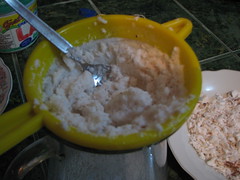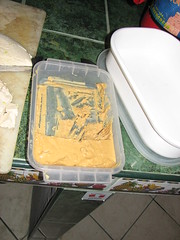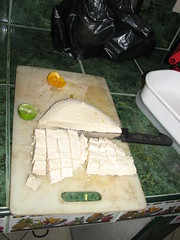May 17th, 2008
Nadando Rama. An effort to make Thai food in a small mountain village.
After 3 months of eating in Peru (and shocked at how much white rice is consumed, I think more so than the revered potatoes) and finally having a somewhat enjoyable kitchen to cook in, I decided it was time to play around and make my biggest meal craving, Swimming Rama.
My prior shared kitchen experiences included a nosy old lady telling me I was boiling beans incorrectly and a middle aged Evangelical woman who was not as nosy but wanted to talk religion to me. In Leymebamba, where my husband and I were volunteering as English teachers to local guides and children, we had access to a big kitchen (and restaurant) under construction.
So, my free time in that month included figuring out how to make foods from scratch. Peanut butter was not available, nor coconut milk or tofu, main ingredients in the Swimming Rama. It took me about a week to find all the ingredients and get things started. Swimming rama consists of rice, spinach, bean sprouts, tofu and a sauce based of peanut butter, coconut milk and chilies. I have had the best SR of my life in Seattle and am now scared to order it from any other Thai restaurant. But being isolated in a small town in the mountains, one tends to forget what things taste like if you are not around them. I could not fail. Luckily, I love making foods from scratch and I had the time and patience.
Step One: make coconut milk. This involved taking a local bus one hour to Yerba Buena for their big Sunday market, where I got a coconut for 15 cents each. They are a big crossroads for jungle food to reach the mountains (mangoes, anyone?) Back home, I stabbed it with the Philips screwdriver I found, drained it of the water and had my husband smash it with the cleaver. Pry coconut meat off and blend with coconut water and enough hot water so your meat:water ratio is 1:1. Strain, refrigerate and wait (hopefully before it goes bad in a few days).
Step Two: make peanut butter. Peanuts were hard to find in our town as well. Only two women sell them and we bought them out. Dry roast peanuts, blend with salt until peanut butter is achieved. See recipe here.
Step Three: make tofu. This process deserves it’s own post. Soybeans are available all over Peru. I have yet to see ANY local use them (except for occasional small towns that produce soy milk to sell to passing buses—buy it! It’s delicious).
Step Four: Give up on the search for mung beans or sprouting anything at all, for that matter. Pesticide use is prevalent in all of South America, thanks to the US banning certain nasty chemicals in the US (which means they still make it, but sell it to South America. yuck!) I am not interested in consuming pesticide-ridden sprouts.
Step Five: Find spinach. The lack of green vegetables makes me very sad indeed. Local markets have an abundance of starches, tubers, roots and tomatoes but the color green is rare. I asked around and was sent to an old lady’s house down the street. She wasn’t home, but her husband let me into her garden and pick what I wanted (no charge). She didn’t have spinach, but there was chard and I grabbed some of that just in case…After about an hour of locals sending me every which way, I was told that some man who works with the TV antennas has a garden and might have spinach. It took me about another hour to find his house, walking around town and asking everyone. I didn’t really understand what they were talking about, antennas and such. I thought he was a local repair man or something. Nope. Finally, I got good directions and climbed the hill to the cemetery and took a steep dirt path along the cemetery’s outer wall and reached a house of rude children and angry dogs. The next house up, located right next to the giant TV antennae for the town, was Max’s. His helpful family trudged with me through his farm at dusk to pick every last leaf of spinach on their farm. I had enough for my dinner for 4 and a happiness to see a local growing broccoli, chard, figs, apples, celery and more.
But I digress. Spinach with the earth still clinging to them went into my pockets and I made it back home in time to finish my dinner. Steam rice, fry tofu, make peanut sauce (using local aji chilies!) and plate. Eat and bask in the pleasure that it is to create a meal completely from local sources, zero packaging, zero middlemen, and knowing that you can make Swimming Rama wherever you are. Life is good.
PS Sorry the pictures are lame, the lighting was not the best.
Recipe for Swimming Rama (Serves 4)
Ingredients
Canola oil (or other, for frying)
1 Tbl aji, minced (the orange one or 1 tsp rocoto/jalapeno)
1 tsp ginger, minced
1 tsp garlic, minced
1/3 cup natural peanut butter (or use normal but don’t add sugar/salt)
1 tsp soy sauce
2 tsp lime juice
1 Tbl sugar
1/2 tsp salt
1/2 tsp ground black pepper
1/2 cup coconut milk
1 lb. firm tofu, drained and cubed
2 lbs. fresh spinach, washed and torn if big
Rice of your choice, cooked as you wish
Peanuts, toasted and chopped
Method
1. Cook rice and drain tofu.
2. Heat a little oil (1/2 tsp) in a saute pan over medium heat. Saute aji, ginger and garlic about 30 seconds.
2. Add remaining ingredients (up to coconut milk) and simmer 1 minute.
3. Slowly add coconut milk, whisking to incorporate and season to taste (salt, lime, aji).
4. Remove from heat and hold until ready.
5. Heat oil in a saute pan (for shallow fry) or a wok or deeper pan (for deep fry). When the oil is hot (test with a drop of water, if it sizzles, it’s ready), add tofu and fry until golden brown and crispy. Be careful not to get splattered with oil. Drain on paper towels.
6. To serve, scoop rice, add spinach and tofu and cover with the sauce. Garnish with peanuts and enjoy! I also like it with mung bean sprouts but those weren’t available in Peru.





May 18th, 2008 at 1:48 pm
Wow… that’s a lot of work for one meal >__<
I’ve never had Swimming Rama but it does sound delicious (mmmmh, PB sauces…). Thankfully, all the ingredients are available at Wong. I don’t think I’d have the courage to do all the work myself although I’d love to learn to make my own tofu.
May 21st, 2008 at 8:25 pm
It was exhausting! I’ll post my recipe for the shortcut version. Let me know how it goes.
September 16th, 2010 at 12:00 am
Hi, Great article